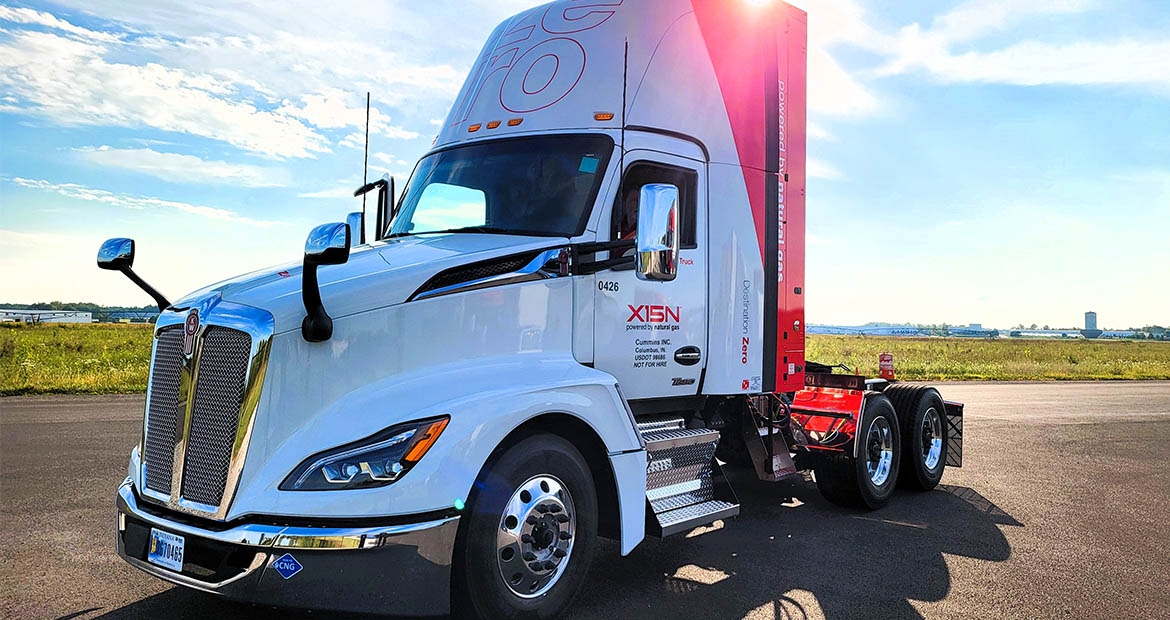Reducing your company’s Scope 3 Emissions with Renewable Natural Gas
By Cummins Inc., Global Power Technology Leader

As sustainability becomes a global priority, companies are exploring ways to cut greenhouse gas emissions across their entire operational footprint. This includes Scope 1 emissions directly under their control, like manufacturing processes. But companies can make a big impact by looking at ways to lower indirect emissions, known as Scope 3. Many companies in industries like food production, manufacturing, retail, and grocery see managing Scope 3 emissions as essential for hitting broader environmental and sustainability goals and satisfying stakeholders. One way for companies to make a major impact quickly is by looking at Scope 3 emissions generated through transportation and the movement of both raw materials used to make their products, and the finished goods that end up with consumers.
As an example, using trucks that run on carbon negative Renewable Natural Gas (RNG) provides a powerful, and simple solution, helping businesses lower Scope 3 emissions and make a meaningful environmental impact.
More on that in a moment, but first, let’s define what Scope 3 emissions really are.
What are Scope 3 Emissions?
To understand Scope 3 emissions, it’s important to know the three categories of emissions outlined by the Greenhouse Gas Protocol, a global standard for measuring emissions:
- Scope 1: Direct emissions from company-owned sources, like fuel burned in company vehicles.
- Scope 2: Indirect emissions from purchased electricity or energy.
- Scope 3: All other indirect emissions resulting from a company’s operations, but outside its direct control.
Scope 3 emissions span the entire value chain, from suppliers to the disposal of products. Examples include emissions from suppliers’ manufacturing processes, third-party transportation, and energy used to produce raw materials.
Often the largest share of a company’s carbon footprint, Scope 3 emissions can be difficult to manage. However, many companies are setting reduction targets in response to regulations, investor pressure, and sustainability goals.
What is Renewable Natural Gas (RNG)?
Renewable Natural Gas (RNG) is an effective solution for reducing emissions, especially in hard-to-decarbonize industries. RNG derives from methane, a potent greenhouse gas released from organic materials like food waste, animal manure, and forest debris decompose. Instead of allowing methane to escape into the atmosphere, RNG projects capture and refine it into a clean, renewable fuel.
This process not only prevents methane's harmful warming effects but also turns waste into usable energy, aligning with circular economy principles that emphasize recycling and reuse. RNG serves as a carbon-neutral—or even carbon-negative—alternative to traditional fuels like diesel and gasoline. Depending on its application in transportation and industrial processes, it helps lower emissions across Scope 1, 2, and 3 categories.
How RNG supports sustainability goals
Renewable Natural Gas (RNG) is gaining traction as a reliable alternative fuel, especially in transportation. Over the past five years, its use in this sector has increased by more than 90%, offsetting around 6.96 million tons of CO₂e emissions—the equivalent of removing nearly 784 million gallons of gasoline from use.
For companies with transportation-intensive operations—such as shipping raw materials, transporting food, or delivering products—RNG-powered fleets offer a practical way to reduce Scope 3 emissions. Businesses can significantly lower their carbon footprint by converting specific shipping lanes or scaling up RNG-powered vehicles.
Industries like food production, manufacturing, and grocery retail can particularly benefit:
- Food Producers: Food processing companies can integrate RNG into their supply chains by converting organic waste into RNG on-site or by collaborating with suppliers who do so. This approach helps cut Scope 3 emissions while turning waste into a valuable resource.
- Manufacturers: Partnering with fleets that use RNG or investing in RNG projects helps manufacturers lower emissions tied to transporting goods, addressing energy-intensive aspects of their operations.
- Retailers and Grocery Chains: Transitioning fleets or contracting RNG-powered carriers creates low-carbon shipping lanes. Grocery stores can also convert their organic waste into RNG, reducing the environmental impact of distribution while supporting sustainability goals.
How RNG can help your customers reach sustainability goals
Reducing Scope 3 emissions may seem challenging, but RNG provides a practical and scalable solution for many industries. Companies can integrate RNG into their operations—whether by directly using it in transportation or contracting RNG-powered fleets—to effectively cut emissions.
Collaborating with suppliers, logistics providers, and other partners to adopt RNG can amplify sustainability efforts across the supply chain. As more businesses invest in RNG and its infrastructure, the fuel will become more affordable and accessible, encouraging broader adoption and driving meaningful progress toward lower emissions.
If you’re in a logistics, supply chain, or transportation related role, there are several ways to learn more about how to reduce reduce your company’s Scope 3 transportation emissions. Contact your preferred carrier or third party logistics partner and ask them if they have trucks equipped with natural gas engines like the Cummins X15N. Or contact your local energy provider or fuel company and ask if they supply RNG.
Author Profiles

Cummins Inc., Global Power Technology Leader
Cummins Inc., a global power leader, is committed to powering a more prosperous world. Since 1919, we have delivered innovative solutions that move people, goods and economies forward. Our five business segments—Engine, Components, Distribution, Power Systems and Accelera™ by Cummins—offer a broad portfolio, including advanced diesel, alternative fuel, electric and hybrid powertrains; integrated power generation systems; critical components such as aftertreatment, turbochargers, fuel systems, controls, transmissions, axles and brakes; and zero-emissions technologies like battery and electric powertrain systems and electrolyzers. With a global footprint, deep technical expertise and an extensive service network, we deliver dependable, cutting-edge solutions tailored to our customers’ needs, supporting them through the energy transition with our Destination Zero strategy. We create value for customers, investors and employees and strengthen communities through our corporate responsibility global priorities: education, equity and environment. Headquartered in Columbus, Indiana, Cummins employs approximately 70,000 people worldwide and earned $3.9 billion on $34.1 billion in sales in 2024.
Related Tags